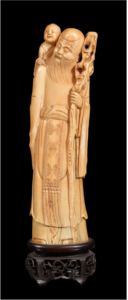The American Society of Appraisers (ASA) has provided its members clarification of the exemptions of the Fish and Wildlife Service (FWS) regulations on the sale of ivory. It is posted here in its entirety:
FWS Releases Proposed Ivory Regulations
Creates De Minimus Exemption; Clarifies Antique Exemption from Director’s Order 210
On July 29, the Fish and Wildlife Service (FWS) released proposed regulations affecting the sale, transfer, donation, or other disposition of African elephant ivory. The regulations, long-expected in the personal property community, prohibit the “sale or offer for sale of ivory in interstate or foreign commerce and delivery, receipt, carrying, transport, or shipment of ivory in interstate or foreign commerce in the course of a commercial activity”. There are, however, several notable exceptions proposed in the regulation.
De Minimus Exemption
FWS has proposed a de minimus exemption for those items which contain a limited amount of ivory that is not the primary driver of the item’s value. Property that meets the de minimus exemption must meet the following requirements:
• Items located in the United States, if the ivory was imported into the United States prior to January 18, 1990 (the date the African elephant was listed in CITES Appendix I) or was imported into the United States under a CITES pre-Convention certificate with no limitation on its commercial use;
• Items located outside the United States, the ivory is pre-Convention (removed from the wild prior to February 26, 1976 (the date the African elephant was first listed under CITES));
• The ivory is a fixed component or components of a larger manufactured item and is not, in its current form, the primary source of value of the item;
• The manufactured item is not made wholly or primarily of ivory;
• The total weight of the ivory component or components in the item is less than 200 grams;
• The ivory in the item is not raw; and
• The item was manufactured before the effective date of the final rule for this action.
FWS provides examples of items it expects to meet the de minimus exemption, such as “the ivory veneer on a piano with a full set of ivory keys”, “insulators on old tea pots, decorative trim on baskets, and knife handles, for example”. FWS also lists examples of items it does not expect to meet the de minimus exemption requirements, such as “chess sets with ivory pieces”, “an ivory carving on a wooden base”, “ivory earrings or a pendant with metal fittings”, or “figurines, netsukes, and jewelry”.
Antique Exemption
The proposed regulation retains an exemption for bona fide antiques, in line with Directors Order 210 as amended on May 15, 2014. This exemption allows for items that are more than 100 years old to be “sold or offered for sale in interstate or foreign commerce and delivered, received, carried, transported, or shipped in interstate or foreign commerce in the course of a commercial activity”. The proposed regulation clarifies, however, that items which were “imported prior to September 22, 1982, and items created in the United States and never imported” are not required to demonstrate that the antique was imported through an endangered species “antique port”. The enumerated requirements for claiming the antique exemption are as follows:
• It is 100 years or older;
• It is composed in whole or in part of an ESA-listed species;
• It has not been repaired or modified with any such species after December 27, 1973; and
• It is being or was imported through an endangered species ‘‘antique port.’’
NOTE: Under Director’s Order No. 210, as a matter of enforcement discretion, items imported prior to September 22, 1982, and items created in the United States and never imported must comply with elements A, B, and C above, but not element D.
As part of substantiating that an item is 100 years or older, those wishing to sell may use a “qualified appraisal”. However, it is unclear under the proposed regulation whether the use of this term ties back to its use for Internal Revenue Service (IRS) noncash charitable contributions. It is also unclear whether the “qualified appraisal” referenced here must be performed by a “qualified appraiser”, as the term is used at IRS, or if other qualifications would be used to determine an appraiser’s ability to perform a “qualified appraisal” for the purposes of this proposed regulation.
Musical Instruments
FWS enumerates four requirements for a musical instrument containing worked ivory to be exempted from prohibitions on import or export. It also reinforces that owners of these musical instruments must provide documentation to support that the ivory was obtained legally prior to February 26, 1976, though FWS clarifies that:
[T]here is sufficient information to show that the ivory was harvested (taken from the wild) prior to February 26, 1976, even though the instrument may not have been manufactured until after that date. It also means that there is sufficient information to show that the ivory was harvested in compliance with all applicable laws of the range country and that any subsequent import and export of the ivory and the instrument containing the ivory was legal under CITES and other applicable laws (understanding that the instrument may have changed hands many times before being acquired by the current owner).
The stated requirements for musical instruments are as follows:
• The ivory was legally acquired prior to February 26, 1976;
• The instrument containing worked ivory is accompanied by a valid CITES musical instrument certificate or equivalent CITES document;
• The instrument is securely marked or uniquely identified so that authorities can verify that the certificate corresponds to the musical instrument in question; and
• The instrument is not sold, traded, or otherwise disposed of while outside the certificate holder’s country of usual residence.
Inheritance/Household Move
In line with Directors Order 210, items containing ivory that are imported or exported as part of an inheritance or household move are exempt from the prohibition, provided that they are for personal use only and accompanied by a valid CITES pre-Convention certificate. However, the regulation clarifies that ivory imported or exported under this exemption “could not subsequently be sold or offered for sale in interstate or foreign commerce or delivered, received, carried, transported, or shipped in interstate or foreign commerce in the course of a commercial activity, even if it qualified under the de minimus exception.” [Emphasis added.] This does not appear to preclude donations of items which are availed under this exemption.
Donations of Items Containing Ivory
Finally, FWS makes clear in the proposed regulation that “[t]he donation of an item consisting of or containing ivory also would not be considered commercial activity, even if the donor qualified for a tax benefit where the tax benefit is not income.” This makes clear that donations of items containing ivory are permissible under the regulation, and can be done to secure a tax deduction for the donor.
ASA continues to review the proposed regulation, and plans to file comments with FWS. For those who wish to file comments, they are due no later than September 28, 2015.



